Mongolia I: From Ulan Bator to the Middle Gobi
Well, she said, with a stunning lack of originality, I'm back. Since a few hours, literally, and what a journey it was. Mongolia is a breathtaking country, and I'll probably spend most of next week making pic spam posts, given the sheer number of photos I took. This despite the fact that after a week, the singing sand dune of the Southern Gobi murdered my camera with its sand, singing or not, which meant from then onwards I had to use my mobile phone as a camera until we were back in Ulan Bator (or Ulaanbaatar, as its inhabitants spell it) for the Naadam Festival. At that point my guide & interpreter kindly lend her camera to me, and I used my old memory card from my old one which was undamaged. But for two weeks in the steppe, the desert and the mountains, it was cell phone or nothing, and I lucked out because that cell phone camera turned out to be not too bad at all. But now, onwards to share some impressions of my Mongolian adventure!
Ulan Bator is easily the least interesting part of Mongolia (when it's not festival time), both because the countryside is so compelling and because by and large, U.B.'s architecture (by the way, the initials UB are actually often used in conversation) is typical for Soviet satellite state capitals. But it does have its attractions. Unfortunately, it also had bad weather right at the start of my journey whereas otherwise, I lucked out and had mostly sunshine all the way. But that first morning? We went to the Gandan monastery and watched the monks call the faithfull to prayer in the pouring rain. Incidentally, my guide, Davaa, is the first person I've met who has Buddhist issues the way other people have Catholic, Mormon or Islamic issues. Meaning: en route to the monastery, she voiced her disgust that so many families send one of their boys to be a Lama at the monasteries, no matter whether the boy likes it or not, and that yes, the boys can choose when they're eighteen, but by then, their childhood had been stolen from them. "Stolen", she emphasized at least three times with anger. On related note, though this part she said in a humorous fashion, she also told an anecdote of once visiting the Gandan temple and spotting one of the boys sweeping and cleaning whereas the others where already eating soup, and she asked why he was the only one; his superior told her that this boy had only mouthed the prayers instead of reciting them out loud, hoping not to be discovered because he hadn't learned them, and so cleaning up duty it was.
Sidenote: the original Mongol religion was schamanistic, and there were several Buddhist "waves", but Buddhism remained a minority religion until the 17th century when specifically Tibetan Buddhism practically converted the entire country. Since then, most Mongols have been Buddhists, with the Dalai Lama also their head of religion. Whenever the current Dalai Lama visits, it causes trouble with the Chinese; after the 2003 visit, they interrupted the Transsiberian Express for two entire days to show their displeasure. The Chinese are spectacularly unpopular in general, but more about that later. Also, their Dalai Lama displeasure is nothing converted to what happend in the 1930s, which was when the local Stalin wannabe carried out Moscow policy, destroyed all the monasteries and killed a great many of the Lamas. This is usually referred to as "the time of repression". So here are the monks of the Gandan monastery in U.B., calling the faithful:


Here's who listened, despite the rain:
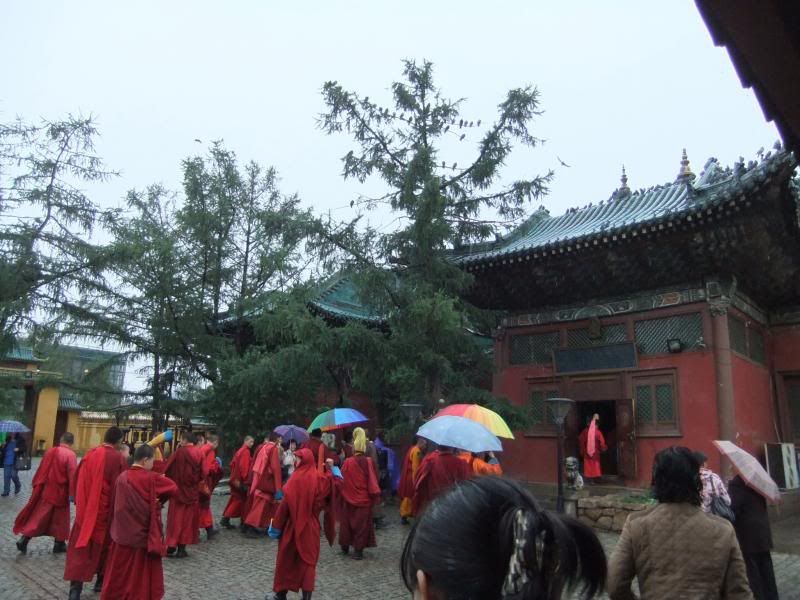

Because most of the monasteries were destroyed and had to be rebuild much later - some as late as the 90s, when Mongolia became democratic - they often have a rather new look. One gigantic statue with a golden veneer had to be rebuild from scratch. They also have ambitions for another one which is supposed to be taller than the statue of liberty when it's done, but meanwhile, there is this:
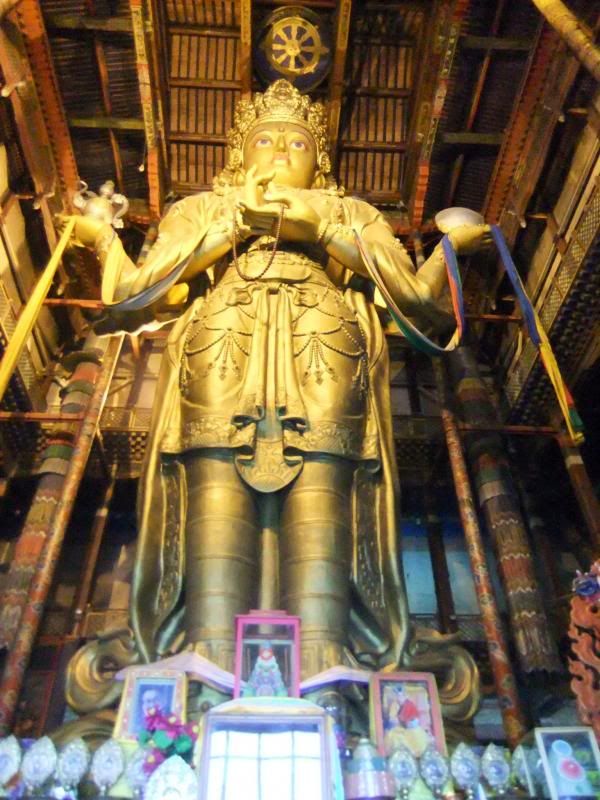
Where the monks dine:
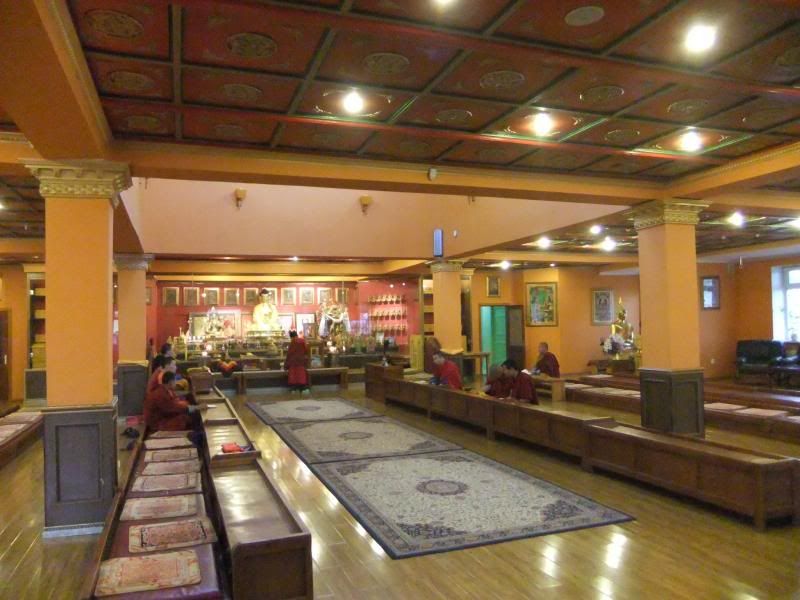
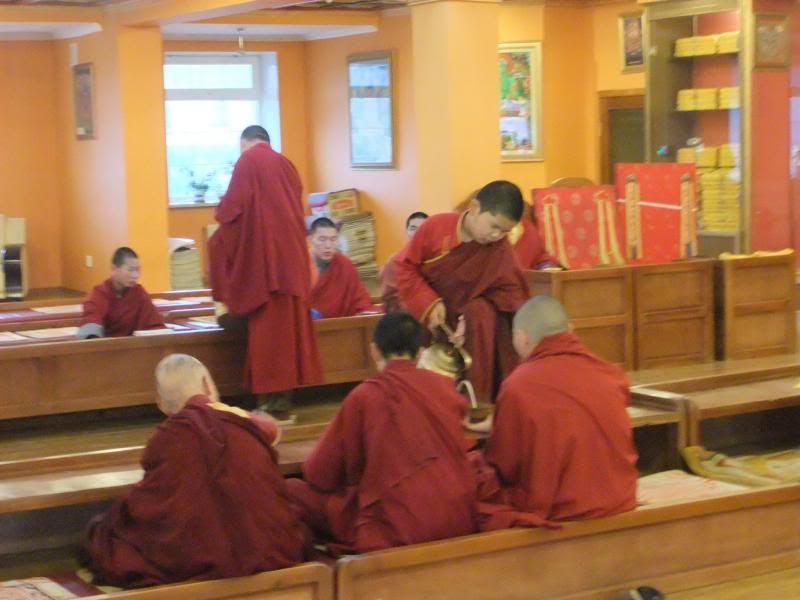
But you know, Buddhism isn't the only religion repressed and coming back. Someone else who made a gigantic comeback in the 90s is Genghis Khan. Or "our great grand father, Genghis Khan", as he's usually referred to. Moscow cultural policy was that he was an evil imperialist feudal brute and butcher. When in the 80s there was a Genghis Khan anniversary approaching, the Mongols prepared for this how one does: a statue was ordered, so were stamps, and an symbosion of historians organized who sent in their papers in advance. One of them said that Russian historians were unfair to Genghis Khan, not putting him in the context of his time. This was a disaster. The stamps had to be withdrawn, the symbosion was cancelled, and the sculptor's career was finished. Nowadays, however, Genghis Khan is again what he was pre-Soviets: the father of the nation, "our great grandfather", after whom practically everything is named. This, the Mongols have a sense of humour about; Davaa told me they joke that even if there is a new toilet to be build, it will be named after Genghis Khan. Also, the Mongolian equivalent of flipping someone off with the erect middle finger is to make a fist and let the thumb look through the middle and the ring finger. Now, another joke goes, at one time Putin is photographed making that gesture. The Mongolian goverment protests with the UNO: "Our great grandfather Genghis Khan made this gesture first. It should be declared our world heritage protected by the UNESCO, and Putin be kept from making it."
So, here's the man himself, once in front of the Mongolian parliament:

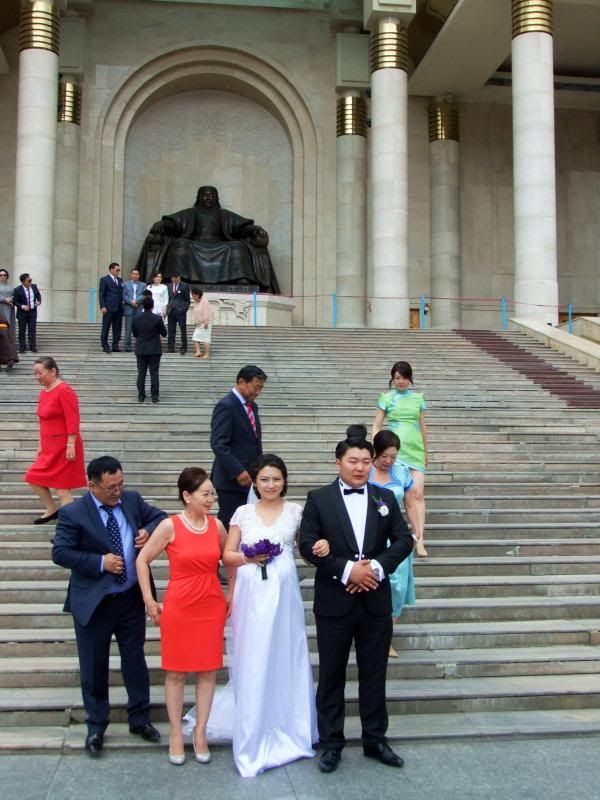
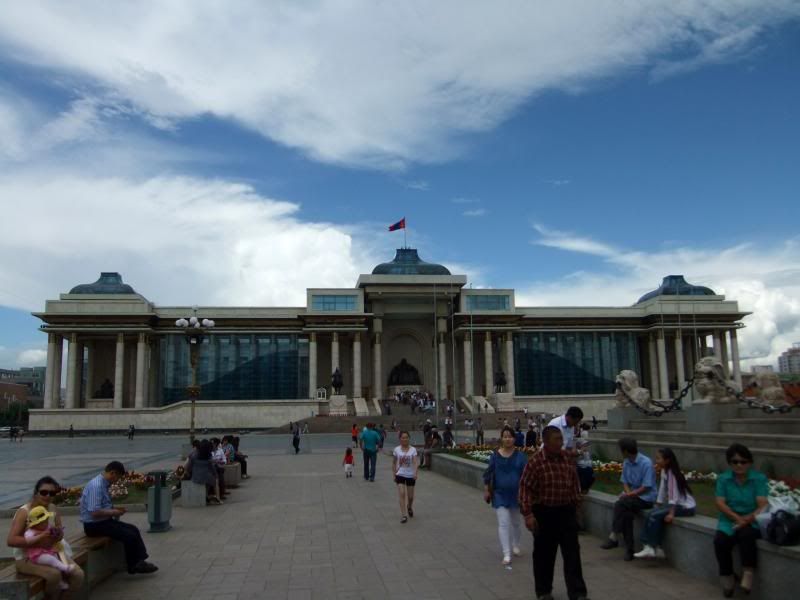
And painted with stones on a nearby hill:

Speaking of views and nearby hills, this is Ulan Bator itself. As you can see, the weather was clearing up:
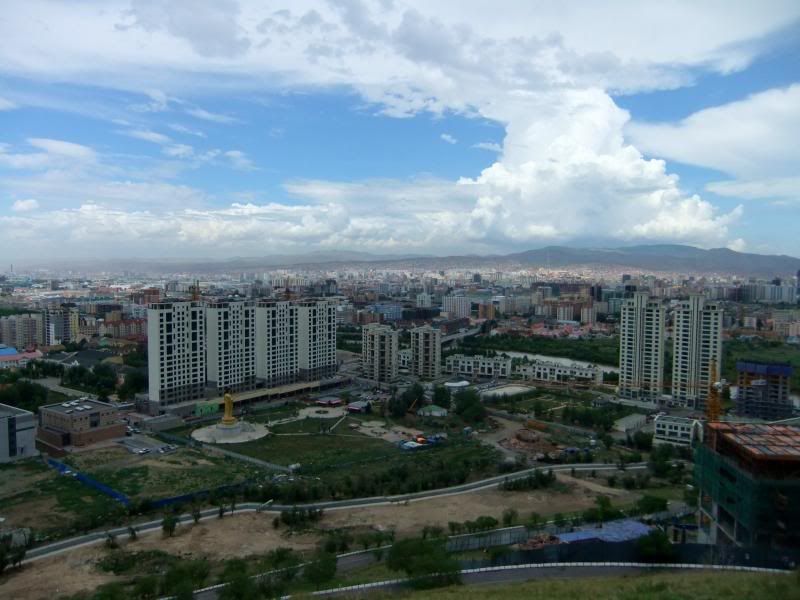
This is the hill the city view was taken from, looked on from down. Yes, the Buddha statue is new, too:
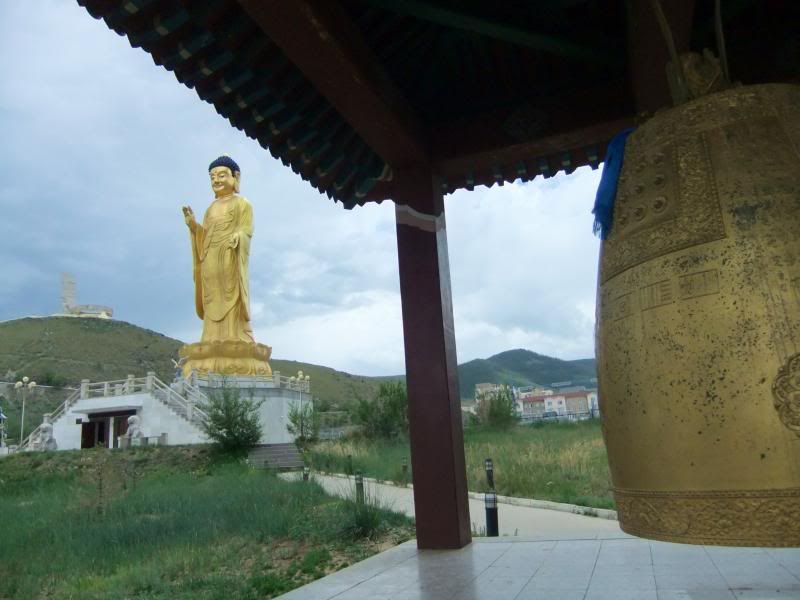
But you can also see what I mean about the architecture. Another exception the Bogd Khan museum, where the last Khans, who were also religious figures post- Tibetan Buddhism conversion, resided:
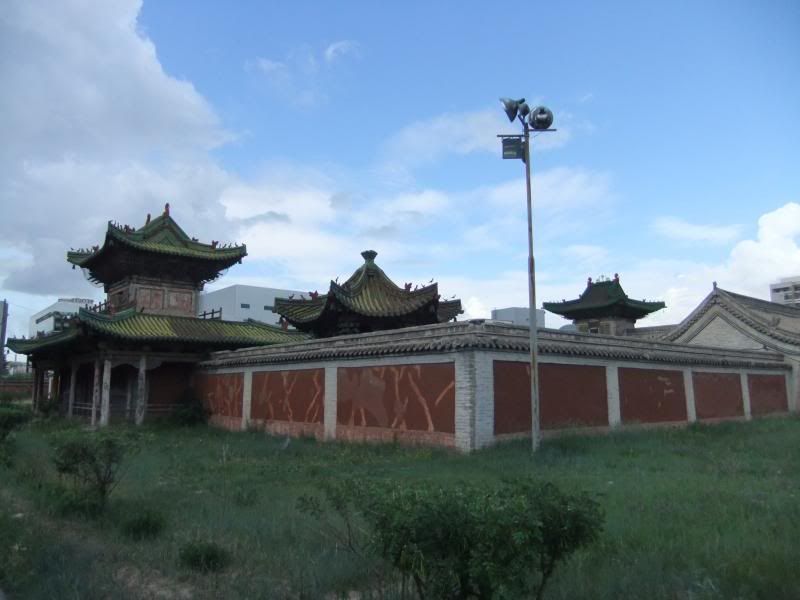
And then there was another decidedly not Soviet satellite state architecture thing, which I discovered while buying water for the journey with my guide, because the big state department store where we bought the water is at the square the monument you're going to see next was. I thought I was hallucinating fannishly, but I was not:
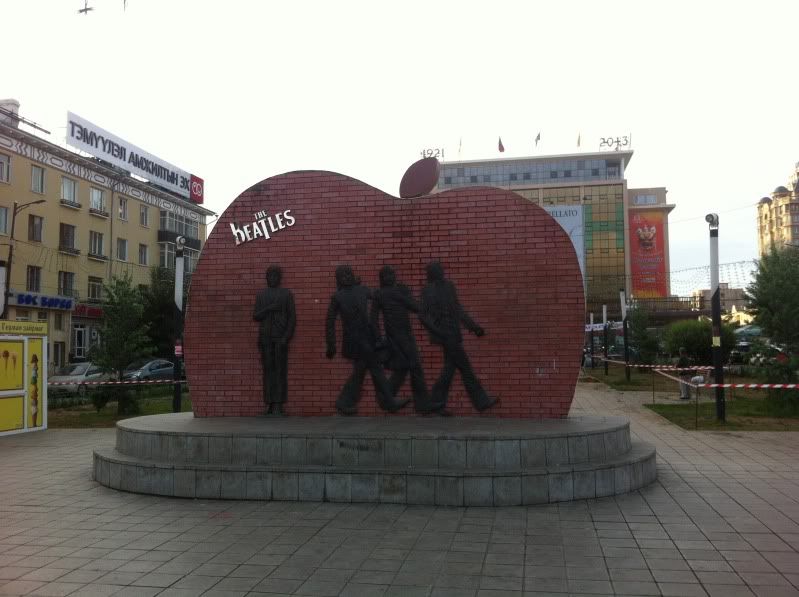
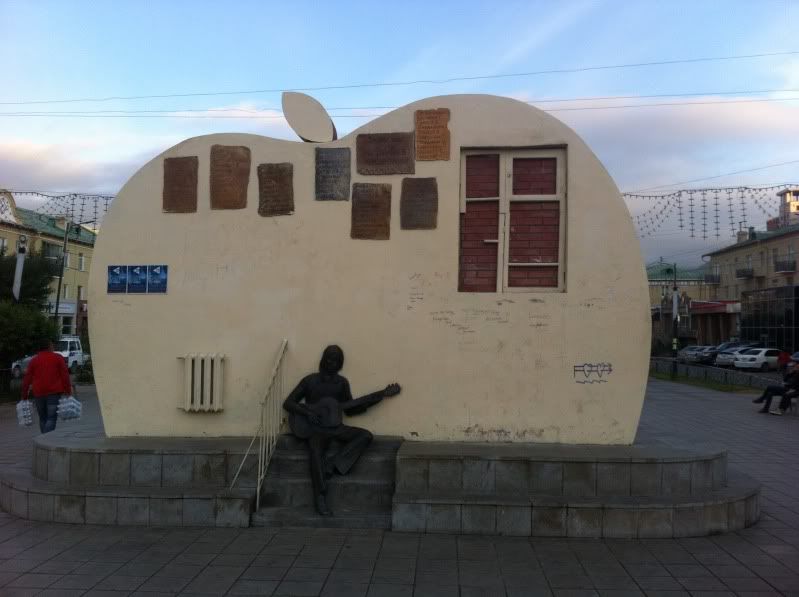
Don't ask me why there is a monument to the Beatles in Ulan Bator. Davaa said just because. Also that the square is named after them.

Well, I just had to. And yes, that's a warm waistcoat I'm wearing despite the fact it was late June. You best dress after the onion principle in Mongolia. Mornings tend to be cold. During the day it can get very hot indeed. Evenings can be warm or cold, it depends.
Buying water, and plenty of it, was absolutely essential, by the way, because you can't resupply in the Gobi. There are camps, and aimag centers, but they are few and far, far away from each other. On the road from Ulan Bator, we stopped so our driver, whose name was Myagaa, pronounced "Meega", could vote, because the day of our departure was presedential election day in Mongolia. Davaa had already voted before picking me up. The voting takes place in schools and gyms of same, as it does in other states, and people sometimes dress up to vote, like these two:
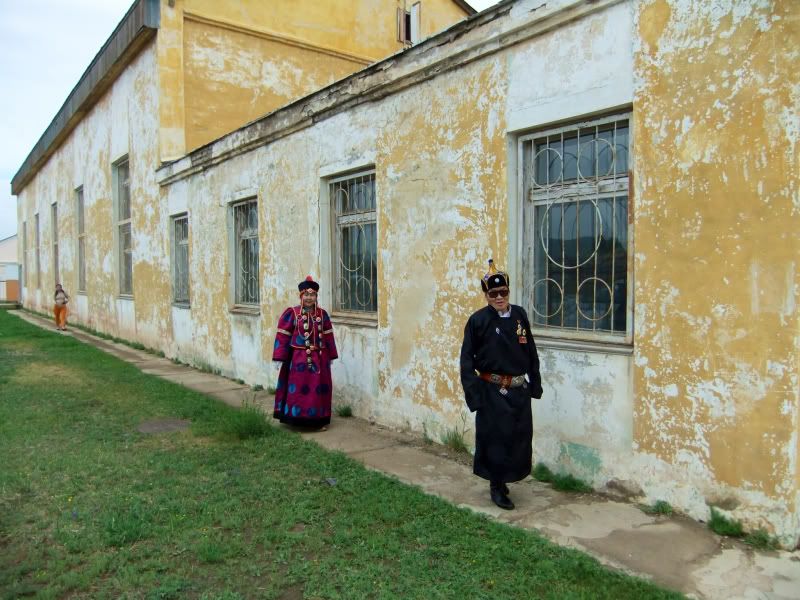

Here's the voting room itself. Also our first but not last indication basket ball is incredibly popular in Mongolia.
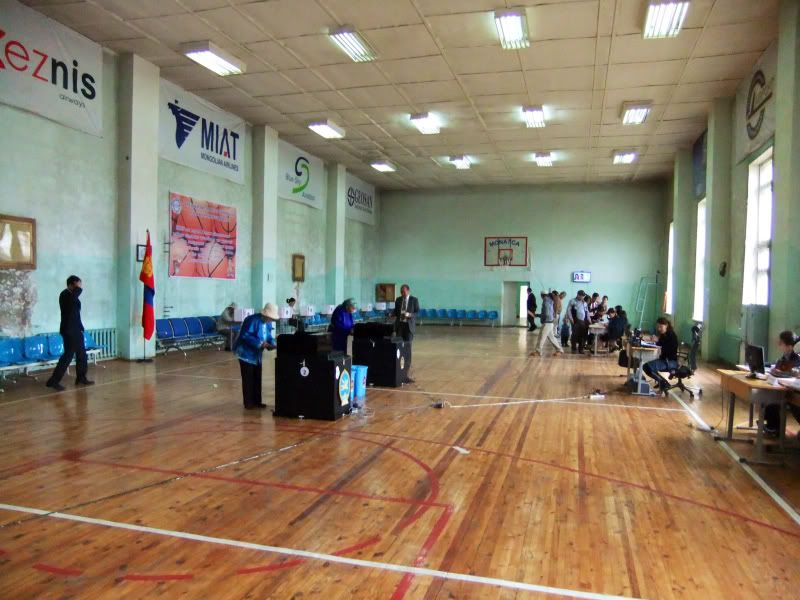
Once we were out of Ulan Bator, we were seeing not only the green hills, but also the herds Mongolia is famous for, and also the yurts. (Or gers, as the Mongols themselves call them; yurts is the Russian word.)
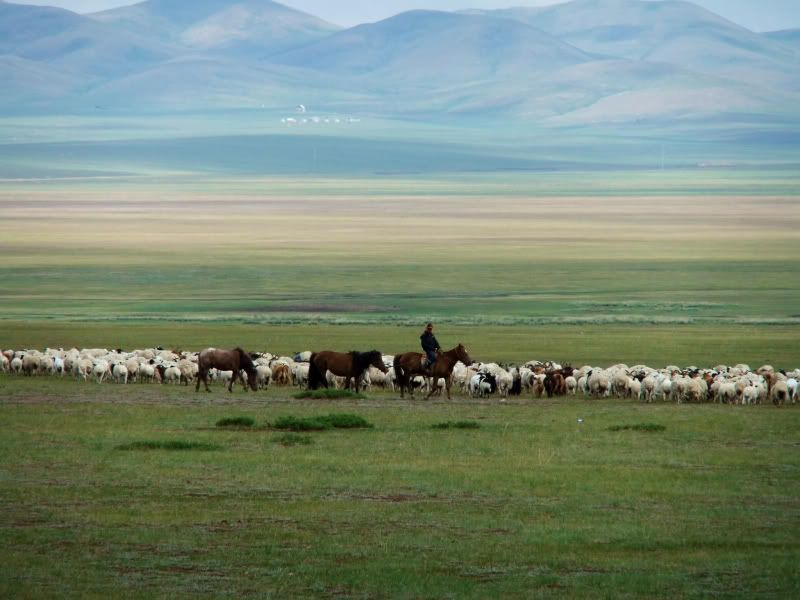

More camels to come. At this point, we had reached the Middle Gobi. Which wasn't quite the stone (and some sand) desert yet you're thinking of; that's the Southern Gobi. The Middle Gobi is mostly steppe; prairie, really. Oh, and I should say something about the roads. Namely, there aren't any. Well, outside the larger Ulan Bator area. It's every Mongol driver for himself, which is one reason why they don't let tourists, either with cars or bikes, drive on their lonesome if at all possible. Navigation systems can't work with no street signs and hardly any roads, and maps aren't much better. "We're a nation of nomads", Davaa said proudly. "We can find the way always."
At one point, we stopped near a herder where sheep shearing was in progress, and we could observe it somewhat. Herds are mixed generally: sheep, goats (more goats than sheep because the goats' hair is used for Chashmere wool) and camels, in the Gobi.
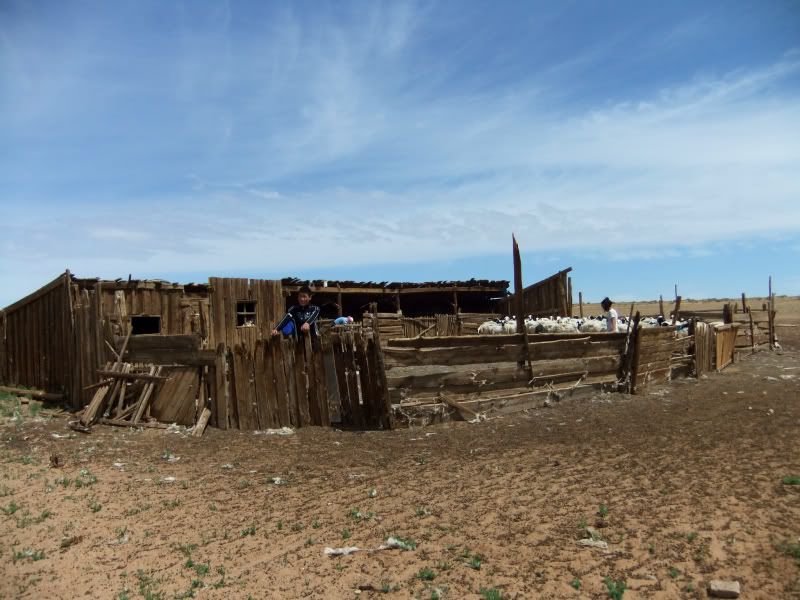
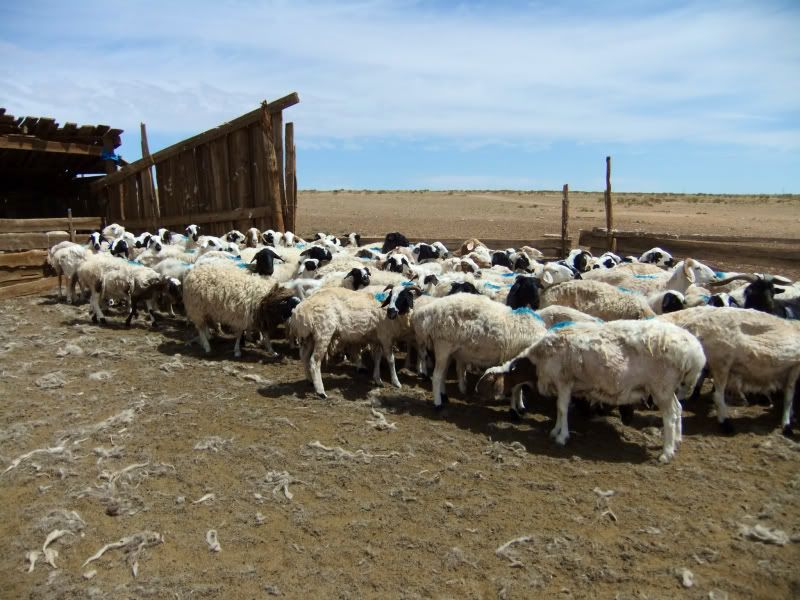
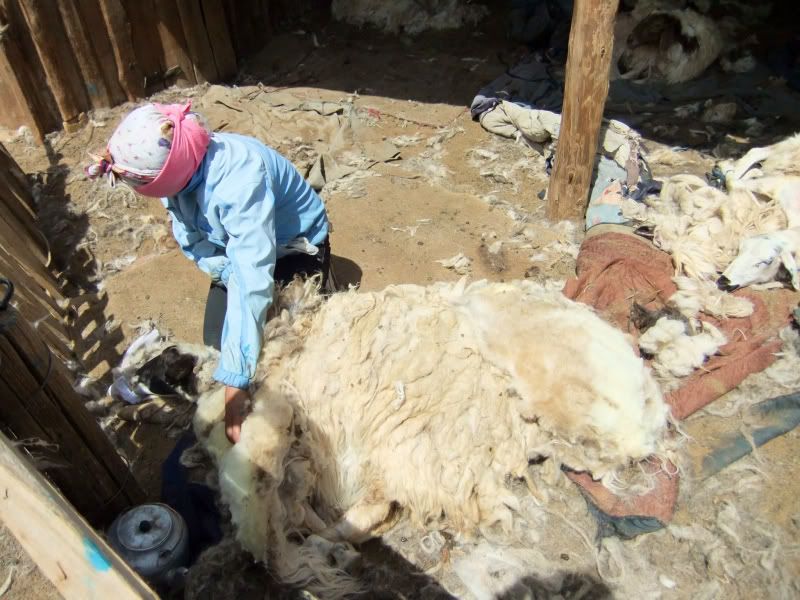
Note she's doing it with scissors. Not electrical ones, either.
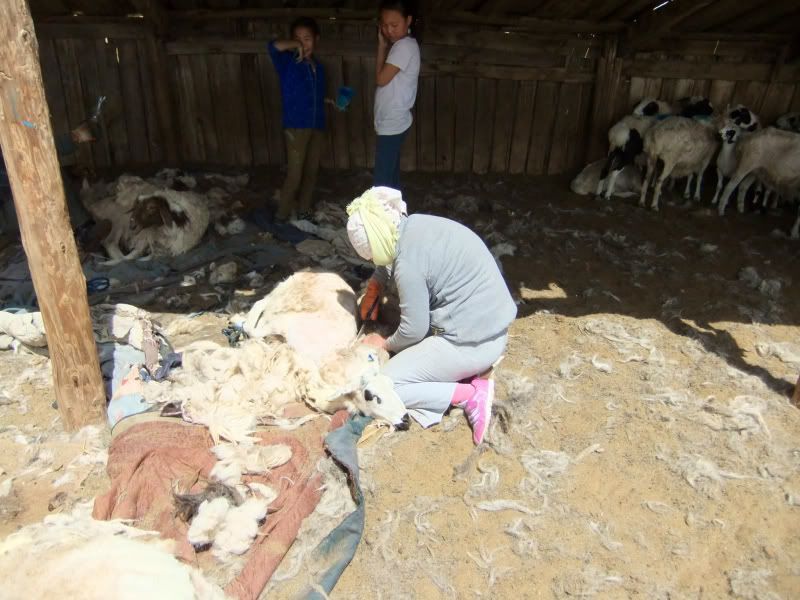
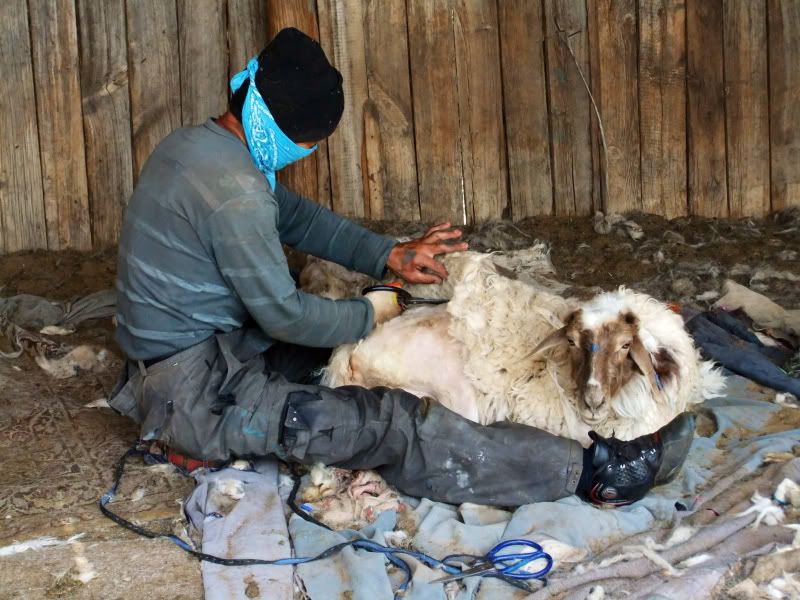

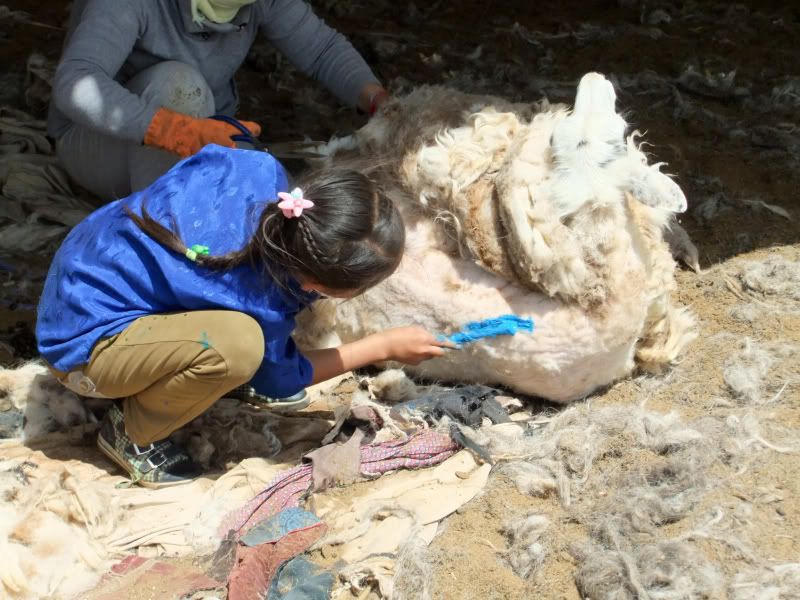
The majority of gers are white, but about a third are army green coloured, too. Usually there is always also a solar cell for energy, and a satellite, as you can see here:
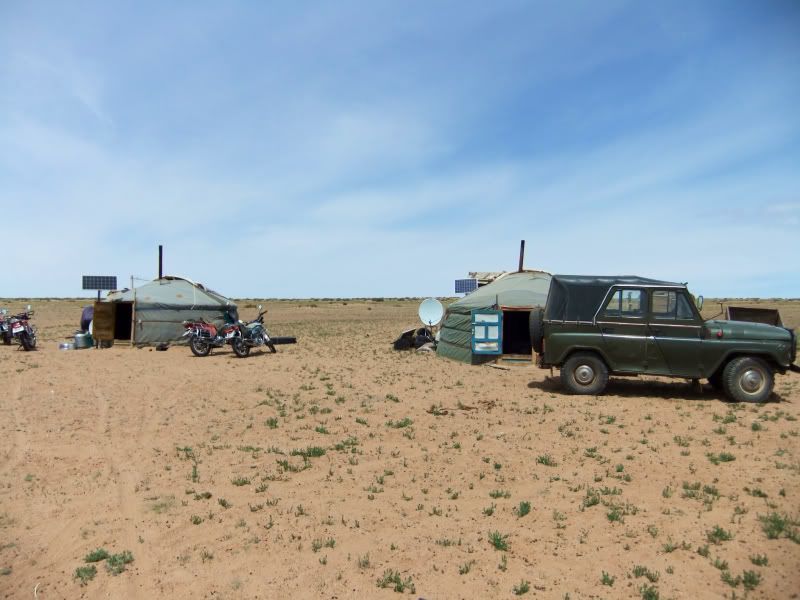
The camels loose their winter fur by themselves, though some are shorn as well. Shame, though, because they look better WITH fur.
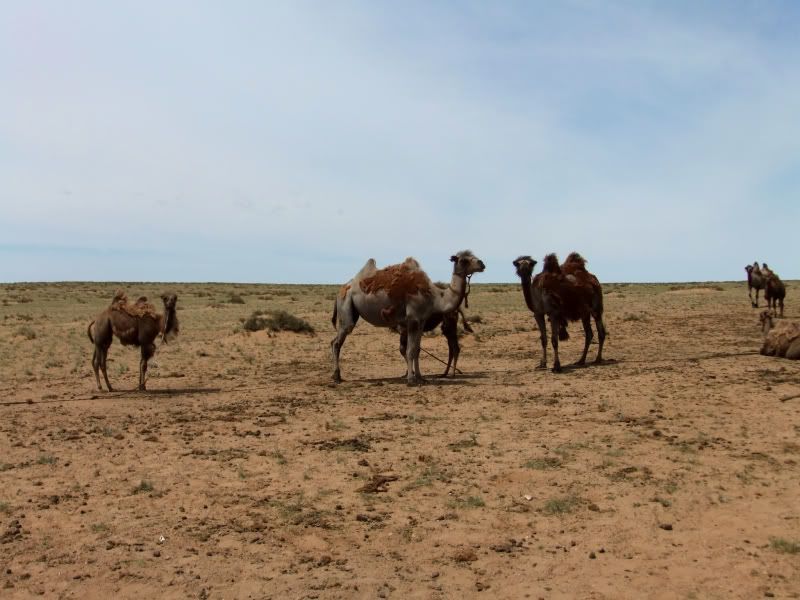
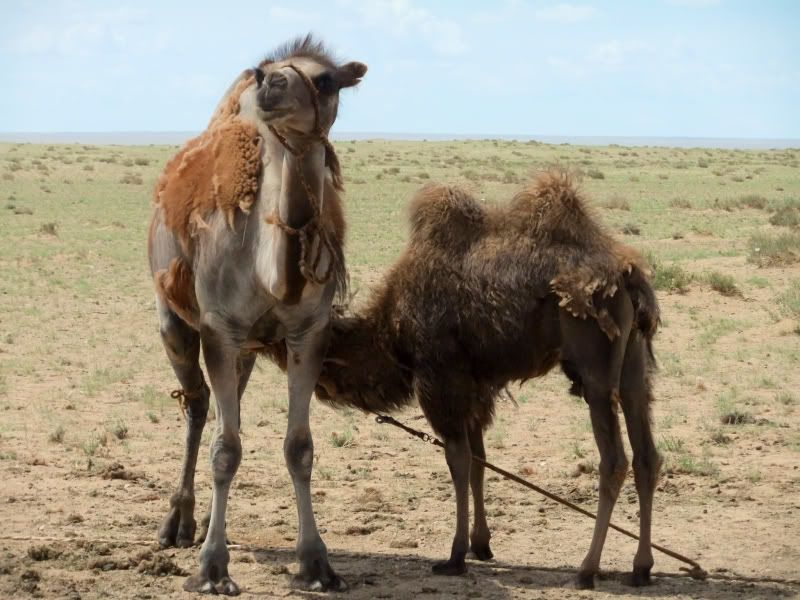
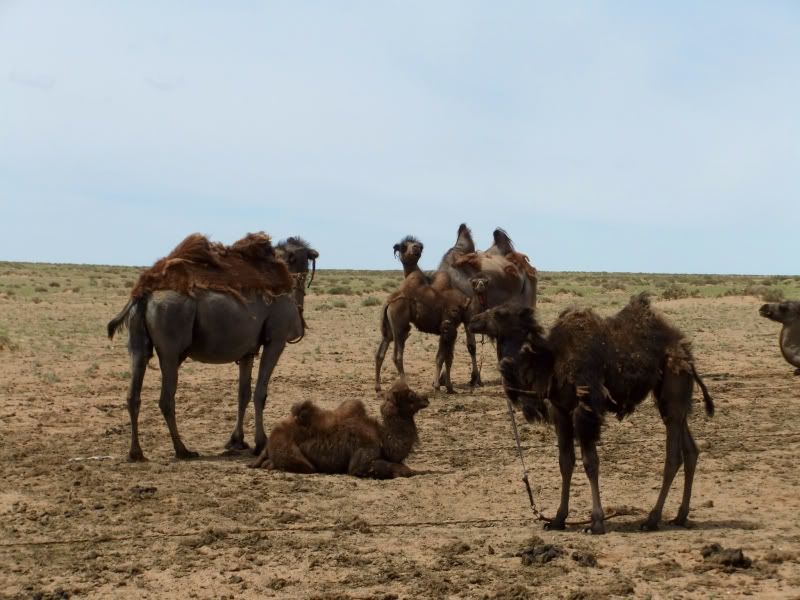
Daava told me camels are thirteen months pregnant. The result is a cutie like this:
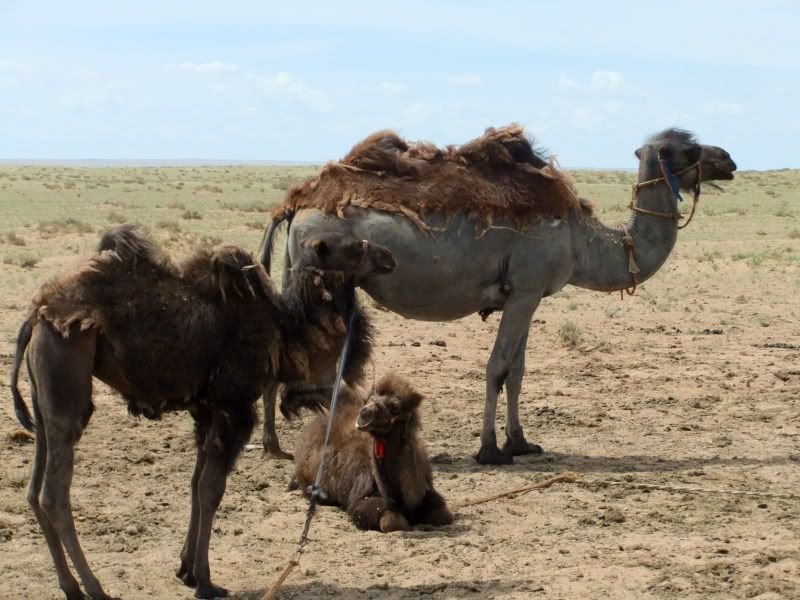
Here's what our first camp looked like. With the exception of the hotel in Ulan Bator, I stayed in a yurt/ger every night through my Mongolian journey:
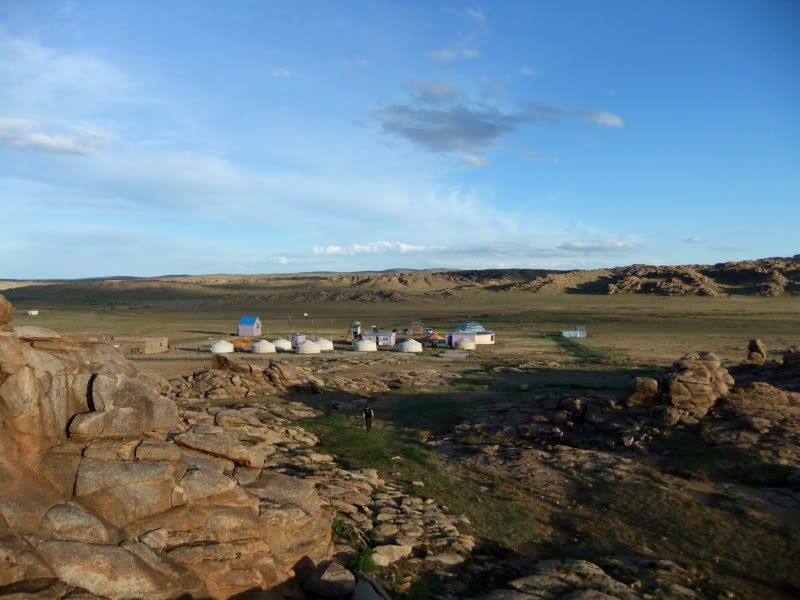
And for a conclusion of my first post on Mongolia, have a look at the two original Mongolian divinities, that first evening in the Middle Gobi: Mother Earth and the Eternal Blue Sky:
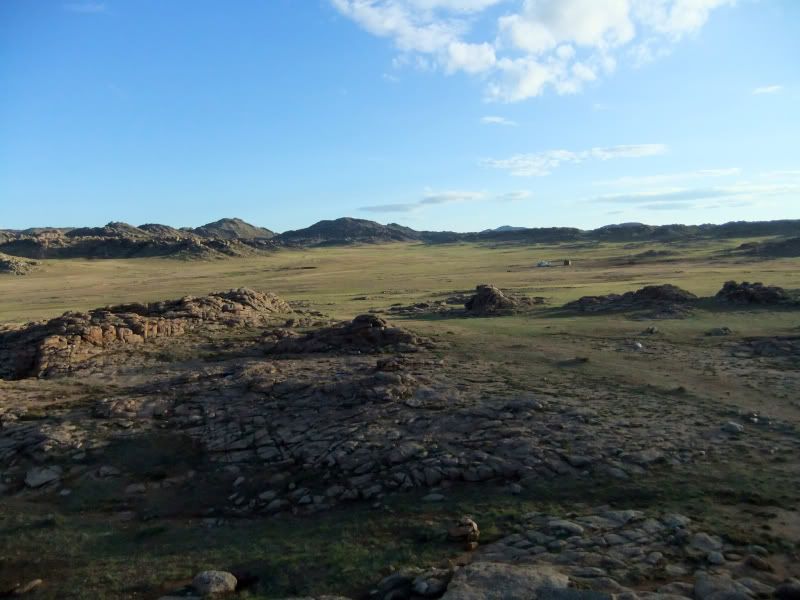
This entry was originally posted at http://selenak.dreamwidth.org/907997.html. Comment there or here, as you wish.
Ulan Bator is easily the least interesting part of Mongolia (when it's not festival time), both because the countryside is so compelling and because by and large, U.B.'s architecture (by the way, the initials UB are actually often used in conversation) is typical for Soviet satellite state capitals. But it does have its attractions. Unfortunately, it also had bad weather right at the start of my journey whereas otherwise, I lucked out and had mostly sunshine all the way. But that first morning? We went to the Gandan monastery and watched the monks call the faithfull to prayer in the pouring rain. Incidentally, my guide, Davaa, is the first person I've met who has Buddhist issues the way other people have Catholic, Mormon or Islamic issues. Meaning: en route to the monastery, she voiced her disgust that so many families send one of their boys to be a Lama at the monasteries, no matter whether the boy likes it or not, and that yes, the boys can choose when they're eighteen, but by then, their childhood had been stolen from them. "Stolen", she emphasized at least three times with anger. On related note, though this part she said in a humorous fashion, she also told an anecdote of once visiting the Gandan temple and spotting one of the boys sweeping and cleaning whereas the others where already eating soup, and she asked why he was the only one; his superior told her that this boy had only mouthed the prayers instead of reciting them out loud, hoping not to be discovered because he hadn't learned them, and so cleaning up duty it was.
Sidenote: the original Mongol religion was schamanistic, and there were several Buddhist "waves", but Buddhism remained a minority religion until the 17th century when specifically Tibetan Buddhism practically converted the entire country. Since then, most Mongols have been Buddhists, with the Dalai Lama also their head of religion. Whenever the current Dalai Lama visits, it causes trouble with the Chinese; after the 2003 visit, they interrupted the Transsiberian Express for two entire days to show their displeasure. The Chinese are spectacularly unpopular in general, but more about that later. Also, their Dalai Lama displeasure is nothing converted to what happend in the 1930s, which was when the local Stalin wannabe carried out Moscow policy, destroyed all the monasteries and killed a great many of the Lamas. This is usually referred to as "the time of repression". So here are the monks of the Gandan monastery in U.B., calling the faithful:


Here's who listened, despite the rain:


Because most of the monasteries were destroyed and had to be rebuild much later - some as late as the 90s, when Mongolia became democratic - they often have a rather new look. One gigantic statue with a golden veneer had to be rebuild from scratch. They also have ambitions for another one which is supposed to be taller than the statue of liberty when it's done, but meanwhile, there is this:

Where the monks dine:


But you know, Buddhism isn't the only religion repressed and coming back. Someone else who made a gigantic comeback in the 90s is Genghis Khan. Or "our great grand father, Genghis Khan", as he's usually referred to. Moscow cultural policy was that he was an evil imperialist feudal brute and butcher. When in the 80s there was a Genghis Khan anniversary approaching, the Mongols prepared for this how one does: a statue was ordered, so were stamps, and an symbosion of historians organized who sent in their papers in advance. One of them said that Russian historians were unfair to Genghis Khan, not putting him in the context of his time. This was a disaster. The stamps had to be withdrawn, the symbosion was cancelled, and the sculptor's career was finished. Nowadays, however, Genghis Khan is again what he was pre-Soviets: the father of the nation, "our great grandfather", after whom practically everything is named. This, the Mongols have a sense of humour about; Davaa told me they joke that even if there is a new toilet to be build, it will be named after Genghis Khan. Also, the Mongolian equivalent of flipping someone off with the erect middle finger is to make a fist and let the thumb look through the middle and the ring finger. Now, another joke goes, at one time Putin is photographed making that gesture. The Mongolian goverment protests with the UNO: "Our great grandfather Genghis Khan made this gesture first. It should be declared our world heritage protected by the UNESCO, and Putin be kept from making it."
So, here's the man himself, once in front of the Mongolian parliament:



And painted with stones on a nearby hill:

Speaking of views and nearby hills, this is Ulan Bator itself. As you can see, the weather was clearing up:

This is the hill the city view was taken from, looked on from down. Yes, the Buddha statue is new, too:

But you can also see what I mean about the architecture. Another exception the Bogd Khan museum, where the last Khans, who were also religious figures post- Tibetan Buddhism conversion, resided:

And then there was another decidedly not Soviet satellite state architecture thing, which I discovered while buying water for the journey with my guide, because the big state department store where we bought the water is at the square the monument you're going to see next was. I thought I was hallucinating fannishly, but I was not:


Don't ask me why there is a monument to the Beatles in Ulan Bator. Davaa said just because. Also that the square is named after them.

Well, I just had to. And yes, that's a warm waistcoat I'm wearing despite the fact it was late June. You best dress after the onion principle in Mongolia. Mornings tend to be cold. During the day it can get very hot indeed. Evenings can be warm or cold, it depends.
Buying water, and plenty of it, was absolutely essential, by the way, because you can't resupply in the Gobi. There are camps, and aimag centers, but they are few and far, far away from each other. On the road from Ulan Bator, we stopped so our driver, whose name was Myagaa, pronounced "Meega", could vote, because the day of our departure was presedential election day in Mongolia. Davaa had already voted before picking me up. The voting takes place in schools and gyms of same, as it does in other states, and people sometimes dress up to vote, like these two:


Here's the voting room itself. Also our first but not last indication basket ball is incredibly popular in Mongolia.

Once we were out of Ulan Bator, we were seeing not only the green hills, but also the herds Mongolia is famous for, and also the yurts. (Or gers, as the Mongols themselves call them; yurts is the Russian word.)


More camels to come. At this point, we had reached the Middle Gobi. Which wasn't quite the stone (and some sand) desert yet you're thinking of; that's the Southern Gobi. The Middle Gobi is mostly steppe; prairie, really. Oh, and I should say something about the roads. Namely, there aren't any. Well, outside the larger Ulan Bator area. It's every Mongol driver for himself, which is one reason why they don't let tourists, either with cars or bikes, drive on their lonesome if at all possible. Navigation systems can't work with no street signs and hardly any roads, and maps aren't much better. "We're a nation of nomads", Davaa said proudly. "We can find the way always."
At one point, we stopped near a herder where sheep shearing was in progress, and we could observe it somewhat. Herds are mixed generally: sheep, goats (more goats than sheep because the goats' hair is used for Chashmere wool) and camels, in the Gobi.



Note she's doing it with scissors. Not electrical ones, either.




The majority of gers are white, but about a third are army green coloured, too. Usually there is always also a solar cell for energy, and a satellite, as you can see here:

The camels loose their winter fur by themselves, though some are shorn as well. Shame, though, because they look better WITH fur.



Daava told me camels are thirteen months pregnant. The result is a cutie like this:

Here's what our first camp looked like. With the exception of the hotel in Ulan Bator, I stayed in a yurt/ger every night through my Mongolian journey:

And for a conclusion of my first post on Mongolia, have a look at the two original Mongolian divinities, that first evening in the Middle Gobi: Mother Earth and the Eternal Blue Sky:

This entry was originally posted at http://selenak.dreamwidth.org/907997.html. Comment there or here, as you wish.